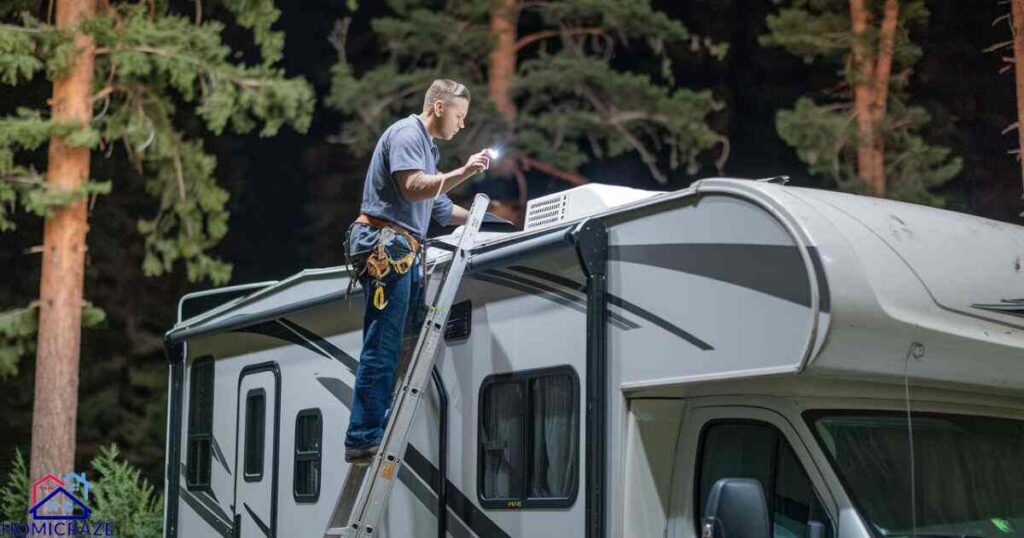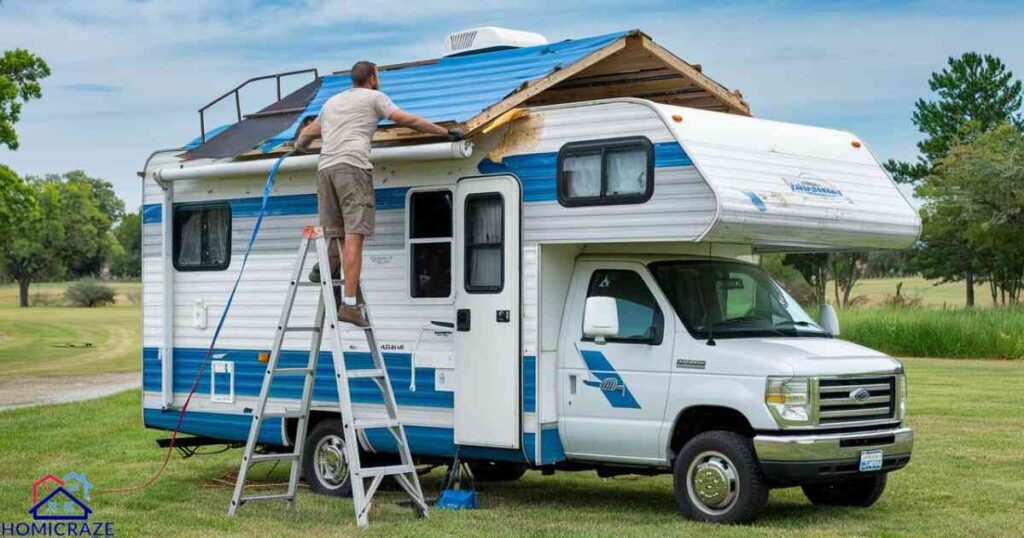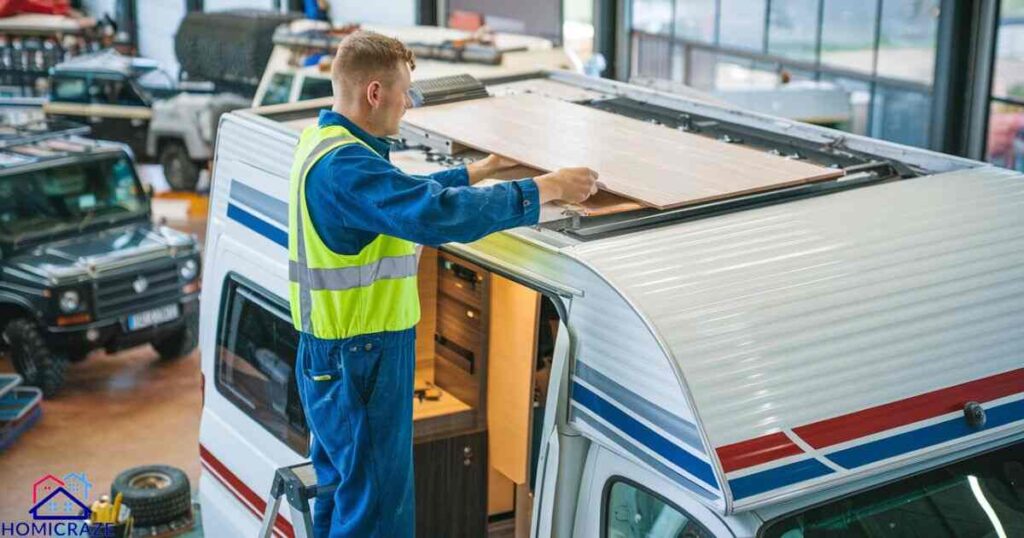Owning an RV brings joy and adventure to many people’s lives. But like any home, it requires maintenance. One crucial aspect is the roof. Many RV owners wonder about the camper roof replacement timeframe. This article will explore the process in detail. We’ll cover everything from identifying damage to the final inspection.
Understanding Camper Roof Replacement
Camper roof replacement is a significant undertaking for any RV owner. It involves removing the old roof and installing a new one. This process is necessary when the roof has extensive damage or has reached the end of its lifespan.
There are several reasons why you might need to replace your camper’s roof. RV roof damage can occur due to age, weather, or accidents. Regular maintenance can extend your roof’s life, but eventually, replacement becomes necessary. Understanding the process can help you prepare for this important repair.
Types of Camper Roofs
RVs come with different types of roofs, each with its own pros and cons. The most common RV roof materials are rubber (EPDM or TPO), fiberglass, and aluminum. Rubber roofs are lightweight and affordable but may require more maintenance. Fiberglass roofs are durable and low-maintenance but can be more expensive. Aluminum roofs are strong but can be noisy during rain.
Knowing your roof type is crucial when considering replacement. It affects the cost, timeframe, and process of replacement. Each material has a different lifespan and repair method. This knowledge will help you make informed decisions about your camper roof replacement.
Signs Your Camper Roof Needs Replacement
Recognizing the signs of roof damage is crucial for timely replacement. Water leaks in RV roof are a common indicator of damage. You might notice stains on the ceiling or walls inside your RV. Soft spots on the roof or bubbling in the roofing material are also warning signs.
Regular RV roof inspection can help catch issues early. Look for cracks, tears, or separation in the roofing material. Check around vents, antennas, and other roof fixtures for signs of wear. If you notice any of these issues, it’s time to consider a camper roof replacement.
Finding RV Roof Damage

Identifying RV roof damage early can save you time and money in the long run. Regular inspections are key to maintaining your RV’s roof. You should inspect your roof at least twice a year, and after any severe weather events.
When inspecting your roof, look for obvious signs of damage like cracks or tears. Also, check for less obvious signs like soft spots or discoloration. Don’t forget to inspect the interior of your RV for signs of leaks. Water stains on the ceiling or walls can indicate roof damage.
Visual Inspection Techniques
Performing a visual inspection of your RV’s roof is the first step in identifying damage. Start by cleaning the roof thoroughly. This will make it easier to spot any issues. Use a ladder to get a good view of the entire roof surface.
Look for cracks, tears, or bubbles in the roofing material. Check the seams and edges for any separation. Inspect around all roof fixtures like vents and antennas. These areas are common spots for leaks. If you notice any issues, mark them for a closer inspection later.
Professional Roof Inspection
While regular DIY inspections are important, a professional inspection can catch issues you might miss. Professional RV roof replacement services often offer inspection as part of their service. They have the expertise to identify potential problems before they become major issues.
A professional inspector will thoroughly examine your roof. They’ll check for structural issues as well as surface damage. They can also provide an estimate for repair or replacement costs. This information is valuable when deciding whether to repair or replace your RV’s roof.
Factors Affecting Camper Roof Replacement Timeframe

The camper roof replacement timeframe can vary widely depending on several factors. Understanding these factors can help you plan for the repair process. It’s important to consider all these elements when estimating how long your RV will be out of commission.
The size and complexity of your RV’s roof is a major factor. Larger roofs naturally take longer to replace. The type of roofing material also affects the timeframe. Some materials are quicker to install than others. The extent of damage and any necessary structural repairs will also impact the timeline.
Roof Size and Complexity
The size of your RV’s roof is a primary factor in determining the camper roof replacement timeframe. A small pop-up camper will take less time to replace than a large motorhome. The complexity of the roof design also plays a role. Roofs with many fixtures or unusual shapes will take longer to replace.
For example, a simple 20-foot travel trailer might take 2-3 days for roof replacement. A 40-foot motorhome with a complex roof design could take up to a week. These are rough estimates and can vary based on other factors.
Roof Material
The type of roofing material you choose will affect both the cost and timeframe of replacement. Rubber roofs (EPDM or TPO) are generally quicker to install than fiberglass or aluminum. However, the preparation and curing time for rubber roofs can add to the overall timeframe.
Fiberglass roofs typically take longer to install but may require less preparation time. Aluminum roofs fall somewhere in the middle. The choice of material should consider not just installation time, but also longevity and maintenance requirements.
Extent of Damage
The amount of damage to your RV’s roof will significantly impact the replacement timeframe. If the damage is limited to the roofing material, the replacement process will be quicker. However, if there’s underlying structural damage, repairs will take longer.
Extensive water damage can require replacing parts of the roof structure. This adds considerable time to the project. In some cases, interior repairs may also be necessary. Always factor in the possibility of discovering additional damage during the replacement process.
Weather Conditions
Weather plays a crucial role in the camper roof replacement timeframe. Most roofing materials require specific temperature ranges for proper installation. Extreme heat or cold can delay the process. Rain or high humidity can also interfere with installation and curing times.
Ideally, roof replacement should be done in mild, dry weather. This ensures optimal conditions for installation and curing. If possible, plan your roof replacement during a season with stable weather in your area. This can help minimize delays and ensure a quality installation.
The RV Roof Repair Process
The RV roof repair process involves several steps, each contributing to the overall timeframe. Understanding this process can help you plan for the time your RV will be out of commission. It’s important to note that while these steps are general, the specific process may vary based on your RV and the repair service.
Typically, the process begins with a thorough inspection and preparation. The old roof is then removed, and any necessary structural repairs are made. Next, the new roofing material is installed. Finally, all seams and fixtures are sealed, and a final inspection is performed.
Preparation Phase
The preparation phase is crucial for a successful camper roof replacement. This phase includes removing all roof fixtures like vents, antennas, and air conditioners. The RV interior may need to be prepared to prevent damage during the replacement process.
The preparation phase can take anywhere from a few hours to a full day. The time depends on the number of fixtures and the condition of the existing roof. This phase also includes gathering all necessary materials and tools for the replacement.
Removal of Old Roof
Removing the old roof is often the most time-consuming part of the process. The time it takes depends on the type of roofing material and its condition. A rubber roof might be removed in a day, while a fiberglass roof could take longer.
During this phase, workers will carefully remove the old roofing material. They’ll also inspect the underlying structure for any damage. Any issues found at this stage could extend the overall replacement timeframe.
Structural Repairs
If any structural damage is found during the roof removal, it must be addressed before the new roof is installed. This could include replacing rotted wood or reinforcing weak areas. The extent of structural repairs can significantly impact the camper roof replacement timeframe.
Minor structural repairs might add a day to the process. More extensive repairs could add several days. It’s important to address all structural issues to ensure the longevity of your new roof.
New Roof Installation
Installing the new roof is the heart of the replacement process. The time this takes depends on the type of roofing material chosen. Rubber roofs can often be installed in a day or two. Fiberglass or aluminum roofs may take longer.
The installation process involves laying the new roofing material and securing it properly. This phase requires precision and care to ensure a watertight seal. Rush jobs at this stage can lead to future problems, so it’s important to allow adequate time for proper installation.
Finishing and Sealing
The final stage of camper roof replacement involves finishing touches and sealing. All seams and edges must be properly sealed to prevent leaks. Roof fixtures are reinstalled at this stage. A final inspection is performed to ensure everything is watertight.
This phase typically takes a day or two, depending on the number of fixtures and the complexity of the roof design. It’s a crucial step in ensuring the longevity and effectiveness of your new RV roof.
Average Timeframe for Camper Roof Replacement
The average timeframe for camper roof replacement can vary widely based on the factors we’ve discussed. However, providing a general range can help you plan for this important maintenance task. Remember, these are estimates and your specific situation may differ.
For most RVs, you can expect the roof replacement process to take between 3 to 7 days. This includes all steps from preparation to final inspection. Smaller campers or simple replacements might be completed in as little as 2-3 days. Large motorhomes or complex replacements could take up to 10 days or more.
Small Camper Roof Replacement
Replacing the roof on a small camper or pop-up typically takes less time than larger RVs. For these smaller vehicles, the camper roof replacement process might be completed in 2-3 days. This assumes there are no major structural issues to address.
The shorter timeframe for small campers is due to the smaller roof area and typically simpler design. However, even with small campers, unexpected issues can extend the replacement time. It’s always wise to plan for an extra day or two in case of complications.
Medium-sized RV Roof Replacement
For medium-sized RVs like travel trailers or small motorhomes, the camper roof replacement process typically takes 4-5 days. This timeframe allows for thorough removal of the old roof, any necessary repairs, and careful installation of the new roof.
The larger size of these RVs means more time is needed for each step of the process. There are often more fixtures to remove and reinstall. The increased roof area also means more time for laying and sealing the new roofing material.
Large Motorhome Roof Replacement
Large motorhomes or fifth wheels usually require the longest time for roof replacement. The camper roof replacement process for these vehicles typically takes 6-7 days, and could extend to 10 days or more for very large or complex roofs.
The extended timeframe for large RVs is due to several factors. The roof area is much larger, requiring more time for removal and installation. These RVs often have more complex roof designs with multiple fixtures. Any structural repairs on a large RV can also be more time-consuming.
Read This Blog: Russian Sleep Experiment: Fact or Fiction
Paying for an RV Roof Replacement
The cost of camper roof replacement is a significant concern for many RV owners. Understanding your payment options can help you prepare for this necessary maintenance. The cost can vary widely based on the size of your RV, the roofing material, and the extent of repairs needed.
On average, you can expect to pay between $3,000 to $15,000 for a complete roof replacement. Small travel trailers might be on the lower end of this range, while large motorhomes could exceed it. It’s important to get detailed quotes from reputable RV repair services to understand your specific costs.
Out-of-Pocket Expenses
Many RV owners end up paying for roof replacement out of pocket. This is often the case if the damage is due to normal wear and tear. The roof replacement cost can be significant, but it’s an important investment in your RV’s longevity.
To manage out-of-pocket expenses, some RV owners set aside money each year for major repairs. Others may use savings or finance the repair. Some RV repair shops offer financing options for large repairs like roof replacement.
Warranty Coverage
If your RV is relatively new, warranty for RV roof might cover some or all of the replacement cost. Most manufacturers provide a warranty on the roof for a certain number of years. However, these warranties often have specific conditions and may not cover all types of damage.
It’s important to review your warranty carefully if you’re considering a roof replacement. Some warranties require regular maintenance and inspections to remain valid. Keep records of all roof maintenance to support any warranty claims.
Types of Insurance Coverage for RV Roof Replacement
Insurance for RV roof damage can be a lifesaver when facing expensive repairs. However, not all insurance policies cover roof replacement. Understanding your coverage can help you plan for potential roof issues.
There are typically two types of insurance that might cover RV roof replacement: comprehensive coverage and collision coverage. Each type covers different scenarios, so it’s important to understand what your policy includes.
Comprehensive Coverage
Comprehensive RV insurance typically covers damage from events out of your control. This might include storm damage to RV roof, falling objects, or vandalism. If your roof is damaged in a storm, for example, comprehensive coverage would likely pay for the replacement.
Also Read This Blog: Kirk Herbstreit house has expansive outdoor space including a pool.
However, comprehensive coverage usually doesn’t cover damage from normal wear and tear. It also might not cover damage due to lack of maintenance. Review your policy carefully to understand what scenarios are covered.
Collision Coverage
Collision coverage for RV comes into play if your roof is damaged in an accident. This could include hitting a low-hanging branch or overpass. It might also cover damage if your RV rolls over.
Like comprehensive coverage, collision insurance typically won’t cover normal wear and tear. It’s specifically for damage that occurs while your RV is in motion or involved in an accident.
Post-Replacement Inspection
A thorough inspection is crucial after the camper roof replacement is complete. This inspection should check all seams, fixtures, and edges to ensure everything is properly sealed. The interior should also be inspected for any signs of leaks.
During this inspection, ask the repair service to explain any maintenance requirements for your new roof. Understanding how to care for your new roof can help extend its lifespan and prevent future issues.
Maintenance Tips for New Roofs
Proper maintenance is key to maximizing the lifespan of your new RV roof. Regular roof maintenance for RV can prevent small issues from becoming major problems. It can also help maintain your warranty coverage.
Inspect your roof at least twice a year, and after any severe weather. Clean the roof regularly to prevent debris buildup. Re-seal around fixtures and edges as needed. If you notice any issues, address them promptly to prevent further damage.
Frequently Asked Question
How long does a typical RV roof replacement take?
A typical camper roof replacement takes 3-7 days. Small campers might be done in 2-3 days. Large motorhomes could take up to 10 days or more. The exact time depends on various factors like roof size, material, and extent of damage.
Can I use my RV during the roof replacement process?
Generally, you can’t use your RV during roof replacement. The process requires full access to the roof and often the interior. It’s best to plan for alternative accommodations during the repair timeframe.
How often should I replace my RV roof?
The RV roof lifespan varies based on material and maintenance. With proper care, most roofs last 10-20 years. Regular inspections can help you determine when replacement is necessary. Don’t wait for leaks to appear before considering replacement.
Can I replace my RV roof myself?
DIY RV roof repair is possible but challenging. It requires specific skills and tools. Improper installation can lead to serious problems. For most RV owners, professional installation is recommended to ensure a proper, watertight roof.
How can I minimize the time it takes to replace my RV roof?
To minimize the camper roof replacement timeframe, keep your roof well-maintained. Address small issues promptly. When replacement is needed, choose a reputable service with experience in your RV type. Plan the replacement during good weather conditions if possible.
In conclusion, understanding the camper roof replacement timeframe helps you prepare for this important maintenance task. While the process can take several days, a new roof provides long-term protection for your RV. Regular maintenance and timely replacement ensure many more years of happy travels in your home on wheels.
The Final Outcome
After the camper roof replacement process is complete, you’ll have a new, watertight roof on your RV. This not only protects your investment but also gives you peace of mind during your travels. A new roof can significantly extend the life of your RV.
The final outcome should be a roof that looks great and functions perfectly. You should notice an immediate improvement in your RV’s protection against the elements. Many RV owners also report improved climate control inside their RV after a roof replacement.







